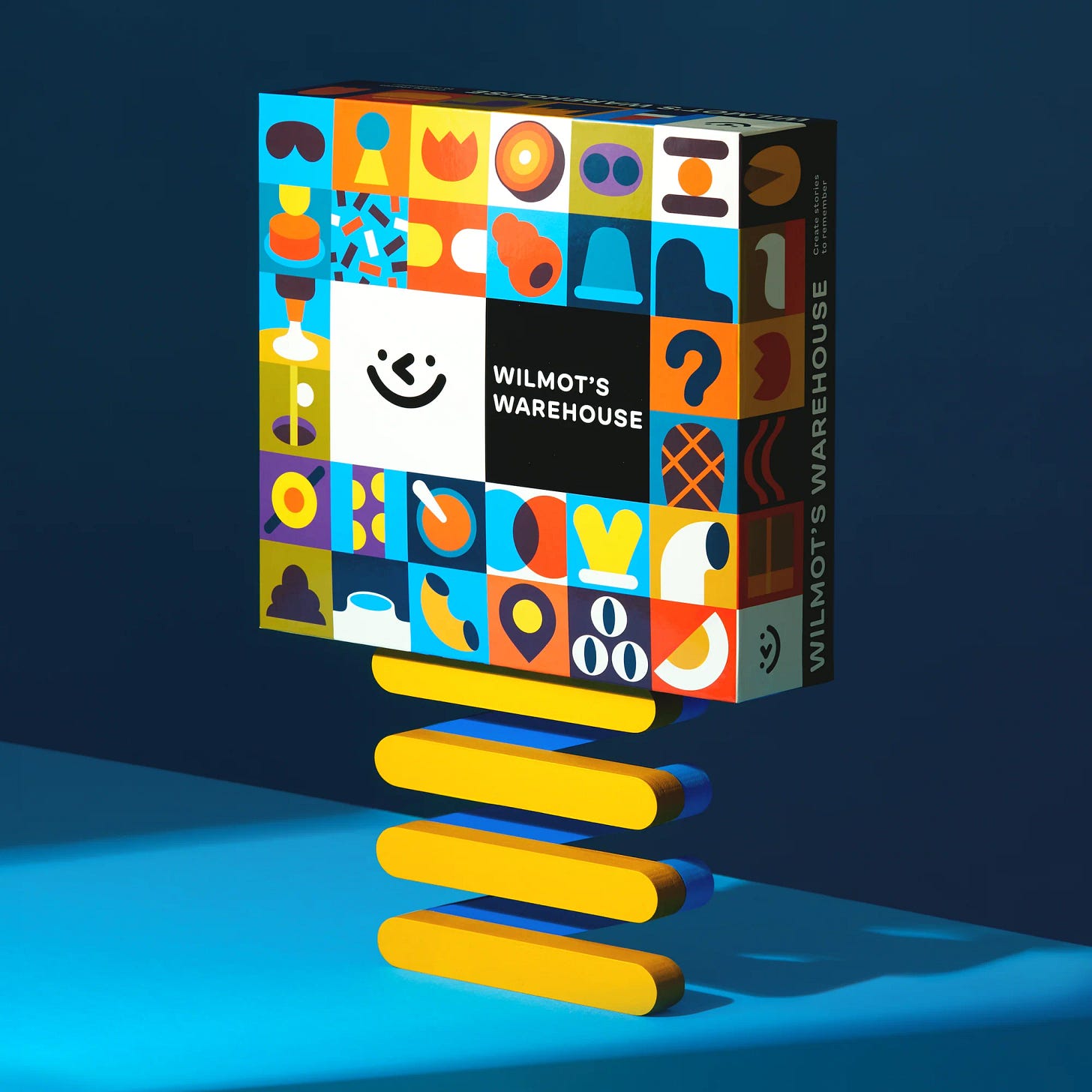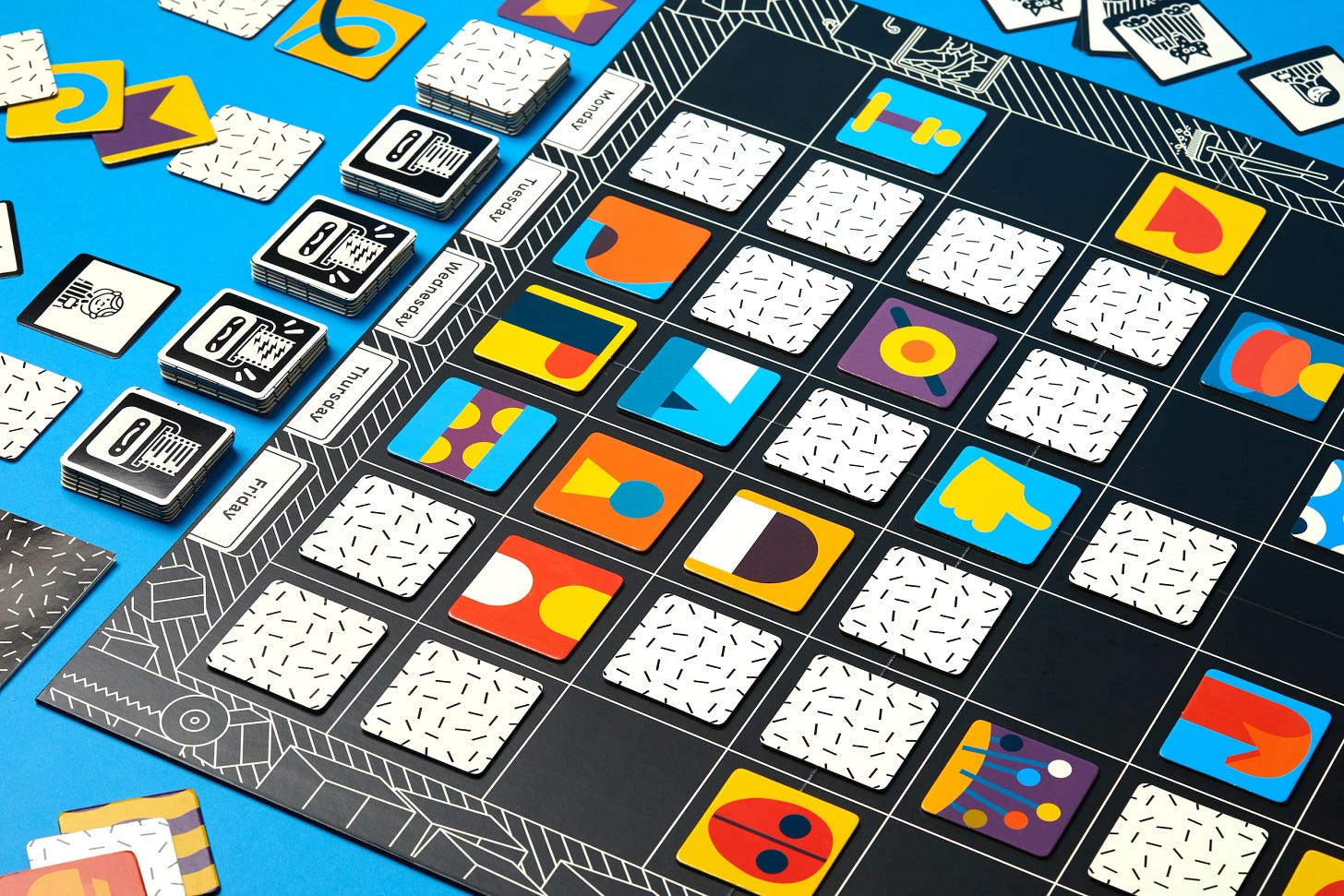Once you’re inside “Wilmot’s Warehouse,” memory is an act of invention. The sensational board game from CMYK is an inversion of that musty game of “Memory” you played when you were a kid. That’s the one where you try and find matching pairs while hunting and pecking for the card you need with every flip. It’s a simple, utilitarian exercise. See something, sear something.
“Wilmot’s Warehouse,” on the other hand, treats memory as a palace and asks you to be the interior designer. It knows that we remember what we imagine, and that we can’t remember forever. Better to revisit the memories we have before they fade.
The game starts you with a blank board, and asks you to set aside 35 tiles. Each is an abstract assembly of colors and shapes; a tile might look like a question mark in one orientation and a hook in another.
There are dozens of these tiles, each with their own variations. A macaroni could also be a phone; a volcano could be a glue bottle; a pistachio could be Pac-Man.
As you play, you reveal one tile at a time, show it to the group, and debate what it is. Your choice isn’t just based on what it looks like, but also how it fits into the rest of the board. So if you placed a macaroni in the center slot, what goes next to it isn’t just a volcano, it’s the volcano in the pasta-maker’s hometown. And it’s not just Pac-Man beneath the volcanic chef, it’s an arcade game in the front of the restaurant.
After you decide what each tile is, it’s placed face-down on the board. The only way to remember what’s what is through the connections you created. This kind of improvisational play makes “Wilmot’s Warehouse” perfectly suited for kids. It’s a storytelling game, not a memory game. Since we bought it, N and I have built a candy cane factory whose alarms went off when somebody found the spies in the bushes outside. We’ve been to a dance party that raged until aliens came through and interrupted it. And we’ve helped knights defend a castle with their shields as bears scratched at the walls.
Or at least I think that’s what the stories were. Because as unforgettable as our storylines were while we were playing, they evaporated the moment the game ended. Was it a candy cane factory or a sprinkles factory? I know there was a dance party, and some aliens, but were those in two different play sessions? And the knights were defending something… but maybe it was the bears and not the castle?
Parenting is its own act of invention. Every night I sing a triptych of songs to J, my 2.5-year-old: “Good Night, Little J,” “Go to Sleep, Little J,” and “J, Hallelujah.” I couldn’t tell you their provenance, only that they started and haven’t yet ended. After all these renditions, their words mean nothing. It’s their role that’s meaningful. In that way, they feel permanent.
Except we know even the most sacred of memories can decay. I sang a set of songs to N when she was J’s age, but I can’t summon them any longer. I think I may have adapted one of N’s for J’s set, but for the most part they’re gone, covered in the underbrush as N’s roots grew deeper and her limbs grew taller.
“Wilmot’s Warehouse” suggests the way to extend the half-life of memory is to reinforce it -- and to accept that the specifics can’t last forever. As you play the game, you tell the story of your tiles over and over, starting with your first and extending out from there. Each time we recap what’s on the board, N revels in telling the story anew (and being reminded of all of the absurdist details she left out), like she’s a standup finding a new way to deliver the joke she’s been telling for months.
But one can only repeat the same routines for so long, in the warehouse and in life. The final act of the game is a mad dash to try and find everything in the warehouse that you’ve stashed away. Everyone works together to do it, shouting out snippets of the bigger story like you’re at a family reunion reliving the time when greedy seagulls swooped down and stole a sandwich out of mom’s hand.
Then, that’s it. You’ve matched the tiles, you get a perfunctory grade, and the game’s over. Thanks for playing. Time to make room for other memories.
As N grew older, the songs I sang to her as an infant weren’t needed like they once were. Instead, I told her nightly stories about the “Brave Kid From Brooklyn,” which were thinly veiled retellings of N’s own day. Then I decided a lifelong devotion to the Mets was more important than any lullaby, so we watched the Mets until she couldn’t keep her eyes open. Soon after we switched to explorations of “Dinotopia,” “Astro Bot,” and “Dory Fantasmagory.”
That evolution -- that story -- is its own memory. And it’s one we invented together.
Yikes, who let all these cobwebs get out of hand around here? I’m a bit dusty, and a bit rusty, but we’re making a go of it. Glad to be back in your inboxes. Looks like I first started writing this in January. Whoops.
Would you like to buy Wilmot’s Warehouse? You can for $35-$40 (sale depending), at CMYK’s website. I leave out some rules when playing with kids, but including them makes the game wonderful to play with adults, as well.
Thanks to this nicely-written blog post from Space-Biff for introducing me to the game in the first place. Also, I should disclose that I’ve spoken to one of the game designers of “Wilmot’s Warehouse” about working together on something for my day job. I expressed my admiration for the game directly to him more or less the same way I did here. We have no financial relationship as of this writing.
Were you so shocked to see my name in your inbox again that you want to tell others about the newsletter? Wonderful! Will they want to know how often it comes out? If so, that makes two of us.
Are you that friend who received the forwarded email? Welcome! Subscribe as you see fit.
Want to tell me what kids’ media to write about next? Nothing stopping you! Message me!





